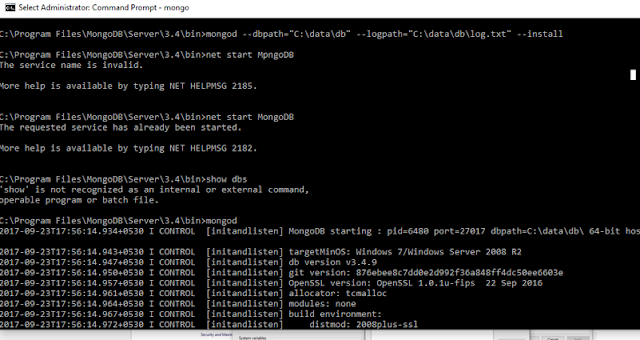Routing refers to determining how an application responds to a client request to a particular endpoint, which is a URI (or path) and a specific HTTP request method (GET, POST, and so on). Express router is a class which helps us to create router handlers.
Each route can have one or more handler functions, which are executed when the route is matched.
var express = require('express')
var app = express()
app.METHOD(PATH, HANDLER)
- app is an instance of express.
- METHOD is an HTTP request method, in lowercase.
- PATH is a path on the server.
- HANDLER is the function executed when the route is matched.
The following examples illustrate defining simple routes.
Respond with Hello World! on the homepage:
app.get('/', function (req, res) {
res.send('hello world')
})
Respond to POST request on the root route (/), the application’s home page:
app.post('/', function (req, res) {
res.send('Got a POST request')
})
Respond to a PUT request to the /user route:
app.put('/user', function (req, res) {
res.send('Got a PUT request at /user')
})
Respond to a DELETE request to the /user route:
app.delete('/user', function (req, res) {
res.send('Got a DELETE request at /user')
})
Route methods
A route method is derived from one of the HTTP methods, and is attached to an instance of the express class.
The above code is an example of routes that are defined for the GET, POST, PUT, DELETE methods to the root of the app.
Express supports the following routing methods that correspond to HTTP methods:
get, post, put, head, delete, options, trace, copy, lock, mkcol, move, purge, unlock, report, mkactivity, checkout, merge, m-search, notify, subscribe, unsubscribe, patch and search.
There is a special routing method,
app.all(), which is not derived from any HTTP method. This method is used for loading middleware functions at a path for all request methods.
In the following example, the handler will be executed for requests to “/isValid” whether you are using GET, POST, PUT, DELETE, or any other HTTP request method that is supported in the http module.
app.all('/isValid', function (req, res, next) {
console.log('Accessing the Validate method...')
next() })
Route paths
Route paths, in combination with a request method, define the endpoints at which requests can be made. Route paths can be strings, string patterns, or regular expressions.
The characters ?, +, *, and () are subsets of their regular expression counterparts. The hyphen (-) and the dot (.) are interpreted literally by string-based paths.
If you need to use the dollar character ($) in a path string, enclose it escaped within ([ and ]). For example, the path string for requests at “/data/$book”, would be “/data/([\$])book”.
Query strings are not part of the route path.
Here are some examples of route paths based on strings.
This route path will match requests to the root route, /.
app.get('/', function (req, res) {
res.send('root')
})
This route path will match requests to /about.
app.get('/about', function (req, res) {
res.send('about')
})
This route path will match requests to /random.text.
app.get('/random.text', function (req, res) {
res.send('random.text')
})
Here are some examples of route paths based on string patterns.
This route path will match acd and abcd.
app.get('/ab?cd', function (req, res) {
res.send('ab?cd')
})
This route path will match abcd, abbcd, abbbcd, and so on.
app.get('/ab+cd', function (req, res) {
res.send('ab+cd')
})
This route path will match abcd, abxcd, abRANDOMcd, ab123cd, and so on.
app.get('/ab*cd', function (req, res) {
res.send('ab*cd')
})
This route path will match /abe and /abcde.
app.get('/ab(cd)?e', function (req, res) {
res.send('ab(cd)?e')
})
Examples of route paths based on regular expressions:
This route path will match anything with an “a” in the route name.
app.get(/a/, function (req, res) {
res.send('/a/')
})
This route path will match butterfly and dragonfly, but not butterflyman, dragonflyman, and so on.
app.get(/.*fly$/, function (req, res) {
res.send('/.*fly$/')
})
Route parameters
Route parameters are named URL segments that are used to capture the values specified at their position in the URL. The captured values are populated in the
req.params object, with the name of the route parameter specified in the path as their respective keys.
Route path: /users/:userId/books/:bookId
Request URL: http://localhost:3000/users/34/books/8989
req.params: { "userId": "34", "bookId": "8989" }
To define routes with route parameters, simply specify the route parameters in the path of the route as shown below.
app.get('/users/:userId/books/:bookId', function (req, res) {
res.send(req.params)
})
Route handlers
You can provide multiple callback functions that behave like middleware to handle a request. The only exception is that these callbacks might invoke next('route') to bypass the remaining route callbacks. You can use this mechanism to impose pre-conditions on a route, then pass control to subsequent routes if there’s no reason to proceed with the current route.
Route handlers can be in the form of a function, an array of functions, or combinations of both, as shown in the following examples.
More than one callback function can handle a route (make sure you specify the next object). For example:
app.get('/example/b', function (req, res, next) {
console.log('the response will be sent by the next function ...')
next()
}, function (req, res) {
res.send('Hello from B!')
})
Response methods
The methods on the response object (res) in the following table can send a response to the client, and terminate the request-response cycle. If none of these methods are called from a route handler, the client request will be left hanging.
app.route()
You can create chainable route handlers for a route path by using
app.route(). Because the path is specified at a single location, creating modular routes is helpful, as is reducing redundancy and typos. For more information about routes, see:
Router() documentation.
Here is an example of chained route handlers that are defined by using app.route().










